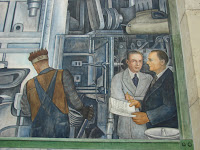


What is art? Paul Cezanne said, “A work of art which did not begin in emotion is not art.” The artwork on Detroit’s Heidelberg Street began in emotion and continues to evoke emotion on many levels. What at first glance looks like a haphazard pile of scraps is artwork that celebrates creativity and hope in the midst of despair.
It was raining lightly as I walked along the street. It brightened the colors and made the artworks glisten. It wasn’t until I forgot the rain and stopped to inspect one of the artworks more closely that I began to understand the intense emotion involved in their creation. A collection of empty bottles of alcohol was labeled “Found Weapons of Mass Destruction.”
I met up with Tyree Guyton who created the project in 1986. He said when he returned to his neighborhood after a stint in the army and saw how his neighborhood had deteriorated. Standing on his porch he had an epiphany, “…a way to change the neighborhood by taking art to the streets.” Armed with a paintbrush, a broom, and friends, Guyton began by cleaning up vacant lots. From the refuse they collected, they transformed the street into a massive art environment. Vacant lots literally became “lots of art” and abandoned houses became gigantic works of art. All the works have something to say. Guyton suggested, “Take a look at the oven behind you. The shoes, the soles, represents the struggle all races face.” It is a haunting remembrance of the Holocaust.
One house, the Dotty Watty, is covered in bright colored dots. The dots symbolize the unity of all people. We want to “connect the dots between art and the community,” explained Jenenne Whitfield, the project’s Executive Director. “At first I thought it was all just a pile of junk. Slowly I was won over. Now I am passionate about the project; so passionate that I quit my good paying bank job to join the project.”
The Heidelberg Project attracts nearly 275,000 visitors a year and is recognized worldwide. Guyton and Whitfield, recently returned from a European trip where they presented their art project to groups in Germany and Italy. The mission of the project is to improve lives and neighborhoods through art. Today they work with art programs in local colleges and schools. Amazingly, no serious crimes have been reported on Heidelberg Street since the project started.
Later in the day I went to the Detroit Institute of Art, home to one of the country’s greatest art collections. The museum is home to frescos by the renowned Mexican artist Diego Rivera, entitled “Detroit Industry.” Today the panels are considered his most successful work but in the 1930s they caused considerable controversy due in part to Rivera’s Marxist philosophy. Controversy can be a good thing because people flocked to see what the fuss is about. While not as controversial the renovated DIA reopened in 2007 with art displayed in an innovative ways designed to appeal to those with all levels of art expertise. The paintings and artifacts in the “Splendor by the Hour” gallery are displayed in a way that it takes visitors through the life and times of the wealthy in 18th century Europe. Children will love the Eye Spy activities. There is art for everyone in Detroit.
For more information: Heidelberg Project, 313-267-1622, www.heidelbert.org; Detroit Institute of Art, 313-833-4005, www.dia.org.